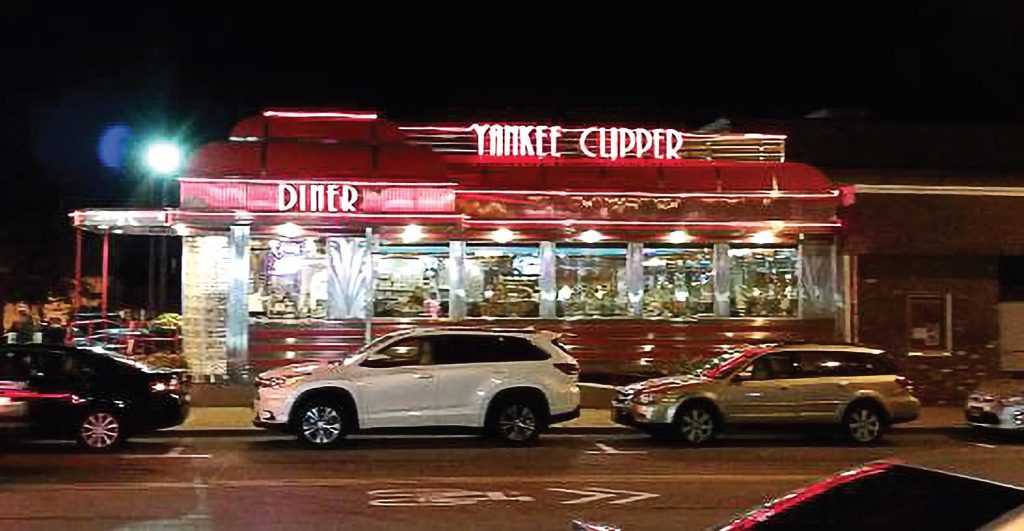Transparency Drives Upper New York’s Pan Gregorian to Success
Posted by estiator at 10 September, at 03 : 23 AM Print
COVER STORY
With the purchasing cooperative’s user-friendly systems, its members can follow the dollars to their bottom line.
BY CONSTANTINE N. KOLITSAS

Talk to a member of the Pan Gregorian Enterprises of Upper New York (PGEUNY) purchasing cooperative and you’ll hear the same conviction: “If it weren’t for the cooperative, we would not be able to compete against the chains.” And, in this there is truth—by pooling the purchasing power of the independent member restaurants, PGEUNY has enabled its members to hold down costs to the point that, in most instances, they pay prices reserved for large national accounts. But today, decades after it first emerged, PGEUNY continues to evolve, employing technology to ensure that the promises of its vendor partners translate into saved dollars on behalf of its members. In a world where transparency is often spoken of but seldom achieved, the Upper New York chapter of Pan Gregorian Enterprises has delivered just that, building out cutting-edge systems to create full transparency into every dollar earned in rebates. Restaurant operators in the cooperative can immediately identify when a rebate or discount doesn’t make it to them.
“One of the things I was tasked to do when first engaged by PGEUNY was to utilize technology to create full transparency for the chapter’s members,” says Lisa Marcinelli, a consultant with FM Creative Solutions, who has spearheaded systems development since 2015. Prior to taking on the assignment with PGEUNY, Marcinelli had been the project manager behind a large-scale software implementation for the New York Stock Exchange’s global real estate and corporate services department, experience she immediately put to use with PGEUNY.
For PGEUNY, Marcinelli developed a proprietary software (simply named “Rebate Tracking System”) that shows each member how much they have earned in rebates on an orderby-order basis, tracking rebates from manufacturers, distributors, and Pepsi, whose deal with PGEUNY earns members tremendous yearly rebates from already low pricing. When members receive their rebate checks, there is no guesswork— every dollar has been tracked and accounted for. “My U.S. Foods rebate isn’t shown on my U.S. Foods invoice,” says one member, “but it comes on the monthly statement I get from PGEUNY.”
Full transparency and the ability to track every dollar earned back are powerful tools when it comes to restaurant owners, a group that is skeptical by nature. Hypotheticals quickly give way to hard facts and figures, along with confidence that every penny earned is received. In fact, PGEUNY has managed its business successfully to the point that for the past five years, members have not had to give up a single penny of their rebates to maintain the group’s operating expenses.
SELF-FUNDING FOR FIVE YEARS
Where large companies employ individual purchasing departments, PGEUNY offers this service for “free,” says Marcinelli, alluding to the fact that for the past five years, the cooperative’s operating costs have been covered through vendor incentives rather than through a share of member rebates. “I don’t know of any other GPO that doesn’t ‘tax’ the member rebates to cover administrative costs,” she says. During this period, PGEUNY’s modest operating budget has been funded by achieving growth targets with its key vendors—meaning that increased membership and adherence to the program have meant more dollars going to the cooperative’s partner vendors, which have earned the organization growth bonuses.
“Because we have hit our growth targets, the members have been able to keep 100% of their rebates,” Marcinelli says. The strategy, she says, is to keep hitting those targets by bringing on new members and encouraging existing members to be loyal to their vendor partners.
And the staff, with Marcinelli’s support and direction, have been successful in containing those administrative costs. “Every purchase, down to every pen used in the office, is recorded and approved by board members,” says Marcinelli, who indicates that in the past four years, PGEUNY has lowered operating costs by 25%. The relocation of the office recently from Poughkeepsie to Fishkill helped toward that end, she adds.
“The members own the cooperative,” she says, “and the Board has a fiduciary responsibility to manage costs in a manner that reflects the group’s best interests. At the end of the year, Marcinelli says, the group shows a zero profit, adding that the cooperative operates as a nonprofit and distributes all monies collected to the members.
KEEPING ON TOP OF PRICING
Several times each year, PGEUNY conducts a detailed pricing analysis to ensure that its members are getting the most favorable pricing possible, says Maria Giannos, the group’s member services manager. The analysis process includes the comparison of prices from member and nonmember invoices over a period of weeks. The team looks at invoices from approved vendors as well as invoices from off-program vendors (nonapproved or nonpartner vendors). In this way, the team can identify if its vendors are truly providing a benefit, as well as to ensure that its vendors are beating pricing from the off-program vendors. “Our prices are better 98% of the time,” says Giannos, and that’s before rebates.
But it’s not only about price. PGEUNY is also focused on quality and service.
“We won’t grab good pricing without good quality,” says board member Chris Zahariadis. “Anyone can get low prices for cheap products; we work with our vendors to find low prices for the products we believe in, and the products that bring customers into our restaurants.”
The vendor-restaurant relationship is an important one, adds chairman Tony Greco, indicating the cooperative’s role in managing those relationships. “The distributors are our partners,” he says. “We meet with them on a quarterly basis, looking for areas of mutual benefit. Of course, the more members we have, and the more our existing members purchase through the program, the better these partners can do on pricing. It’s basic economics.” To maintain balance, the cooperative deals with just two vendors for each category. Having a second partner for each category helps to keep prices competitive, says the group’s president, George Moustakas. “It doesn’t work when you have ten vendors; the leverage isn’t there,” he says, while acknowledging that in some areas, there is territorial overlap with distributors, meaning that in some rare instances a member could have more than two options.
What members need to avoid, he says, is the temptation to deviate from the program.
“From time to time, our members get phone calls from jobbers with one-off specials that undercut the prices they get through PGEUNY,” he says. “These jobbers know our pricing, and they’ll take shots to try to make a quick deal. But these jobbers don’t help our business by giving us an occasional price break; in fact, they hurt it. Our businesses thrive because Pan Gregorian has enabled us to compete against the national chains. If the Pan Gregorian didn’t exist, the prices these jobbers quote would be much higher than the prices we are paying through the cooperative. A case of eggs might be twice the price. It’s because of the cooperative that the pricing level is where it is, and not much, much higher.”
“One of our greatest accomplishments as a group,” adds Greco, “is the fact that we almost dictate pricing. To get our business, our partners have to hold down their margins. If the cooperative didn’t exist, we would all be at the mercy of the suppliers; they would be able to charge much more, and our businesses would suffer.”

PGEUNY works on behalf of its member restaurants, covering all of Upstate New York, including Lake Mohegan (top) and Fishkill.
ADVOCATING FOR MEMBERS
In addition to monitoring, tracking, and negotiating costs, the team at PGEUNY spends a great deal of their time supporting members and advocating for them. If there is a rebate credit that does not turn up on a member’s invoice, for example, Giannos digs into the data to identify the issue and rectify it.
“In some cases, our members will give checks to their distributor reps,” Giannos says. “If the rep forgets to turn it in right away, the member’s prompt payment rebate could be affected. In these cases, I will call the distributor on behalf of the member and make sure that the rebate is applied.”
And because the member can see each rebate earned on each order, it’s easy to identify when an error has occurred. With the Rebate Tracking System, Giannos can access each member’s purchasing and rebate histories, enabling her to easily verify any issues. In fact, Giannos (and the member) will receive an automated message indicating that a rebate was missed.
Giannos also gets involved when a member experiences an issue with a vendor. “Recently,” she says, “a member let us know that case sizes from a manufacturer partner were irregular. We looked into the situation and immediately stepped in and rectified it.”
BUT IT’S NOT ONLY ABOUT PRICE. PGEUNY IS ALSO FOCUSED ON QUALITY AND SERVICE
PLANNING FOR THE FUTURE
While rebates are at the core of Pan Gregorian’s strategy, going forward, says Marcinelli, the focus will be on negotiating even more advantageous pricing, or pricing that deviates more from the market price most nonmembers pay.
“Rebates are great, but members see rebate checks three times a year,” she says. “We always prefer a lower price at invoice than a rebate later. As we make new deals with vendors, we are strategically looking for ways to lower food costs. Higher labor costs are affecting our members, so it is even more critical today to get instant savings.”
Most importantly, perhaps, is the organization’s drive to educate members to understand the benefits of buying on program. Today, members who utilize the program can save at least 7% to 10% off their food cost. “Our deals are directly correlated to the total cases we buy; the more our membership buys, the more the manufacturers are willing to discount. We average $100 million in on-program purchasing annually from our members,” says Marcinelli. “Annual rebates topped $4 million. Those numbers could easily triple if all members bought on-program 80% of the time.”
“The hardest thing for us is to keep our members focused on the end results,” adds Zahariadis. “Compliance and loyalty to the program makes us stronger.”
|About PGEUNY
Pan Gregorian Enterprises of Upper New York was first founded in 1986 by a group of Greek diner owners meeting in Poughkeepsie, with the support of the New Jersey Pan Gregorian (the first of the multi-chaptered organization). Among its founding board members were Tony Moustakas, John Paschalis, Gus Serroukas, John Serroukas, and Nick Stratis.
Territory: PGEUNY begins in Westchester County and covers the remainder of New York State, north and west of New York City.
Members: 534, with more being added weekly
Board Members 2019:
Tony Greco (Chairman)
New Carmel Diner Carmel, NY
George Moustakas (President)
I-84 Diner Fishkill, NY
Chris Zahariadis (Secretary/Treasurer)
Acropolis Diner Poughkeepsie, NY
Leon Anastos (Director)
Broadway Diner Endwell, NY
Steve Moss (Director)
Rock Hill Diner Rock Hill, NY
Petros Petsas (Director)
Yankee Clipper Beacon, NY
Dino Tsagarakis (Director)
Croton Colonial Diner Croton-on-Hudson, NY
Sakis Tyrnas (Director)
Capital City Diner Albany, NY
Staff: Maria Giannos, Member Services Manager, and Morgan Quintana, office administrator
Who can join?: Any restaurant owner operating in its large NY territory can become a member. Restaurants currently buying from its partner distributors (U.S. Foods, Ginsbergs, Gordons, Maines, Maplevale, or Renzi) will save money. Membership is free, and there is no penalty for leaving the cooperative

The historic Yankee Clipper Diner in Beacon, NY















